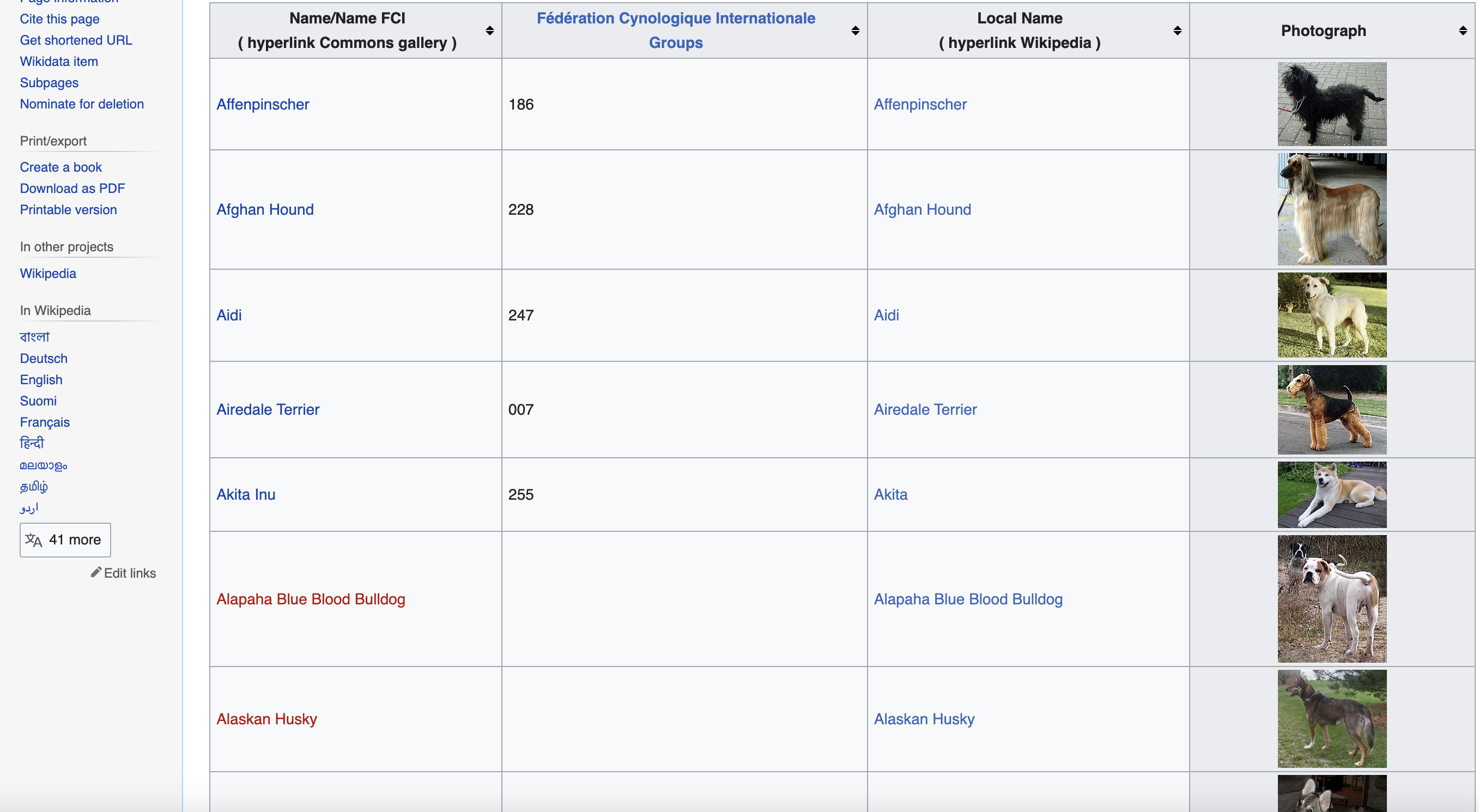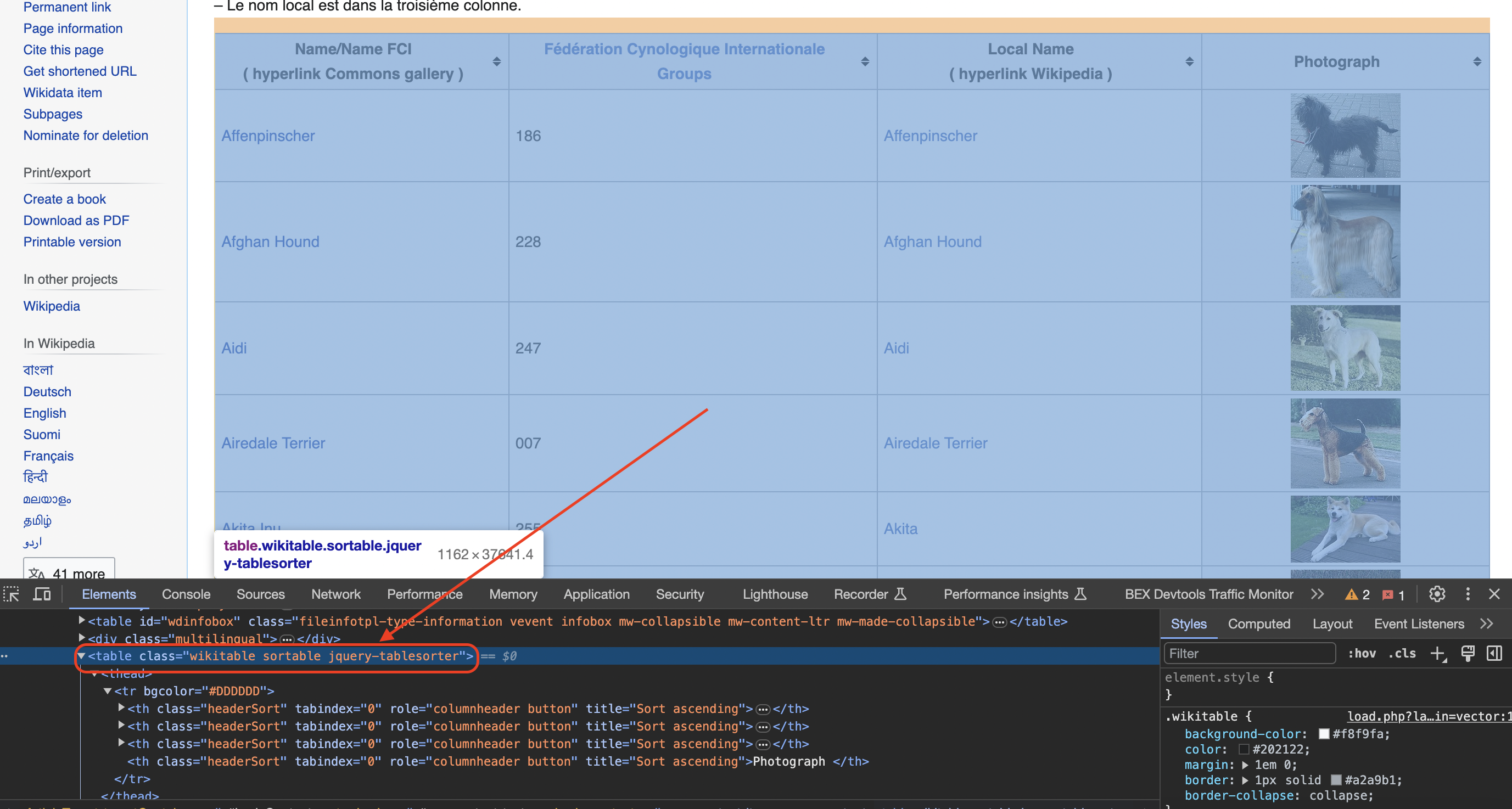Web scraping can automate data collection from websites. In this comprehensive tutorial, we'll scrape a Wikipedia page to extract dog breed information and images using Node.js.
This is page we are talking about…

Getting Set Up
We'll use these Node modules:
npm install axios cheerio fs
const fs = require('fs');
const axios = require('axios');
const cheerio = require('cheerio');
axios makes HTTP requests
cheerio parses HTML and helps query/manipulate DOM
fs provides file system methods
Defining the Target URL
We'll scrape the Wikipedia List of Dog Breeds page:
const url = '<https://commons.wikimedia.org/wiki/List_of_dog_breeds>';
We'll also define a User-Agent header to mimic a real browser request:
const headers = {
"User-Agent": "Mozilla/5.0 (Windows NT 10.0; Win64; x64) AppleWebKit/537.36 (KHTML, like Gecko) Chrome/58.0.3029.110 Safari/537.36"
};
Making the HTTP Request
Let's use axios to fetch the page content:
axios.get(url, {headers})
.then(response => {
// Request succeeded, let's scrape!
})
.catch(error => {
// Handle errors
});
On success, the full HTML is in
Loading and Parsing with Cheerio
To query/manipulate DOM elements, we need to load raw HTML into cheerio:
const $ = cheerio.load(response.data);
The
Extracting the Main Data Table
Inspecting the page
You can see when you use the chrome inspect tool that the data is in a table element with the class wikitable and sortable

We can reference it like this:
const table = $('table.wikitable.sortable');
Initializing Data Arrays
Let's initialize arrays to store extracted data:
const names = [];
const groups = [];
const localNames = [];
const photographs = [];
We'll also create a folder to save images:
if (!fs.existsSync('dog_images')) {
fs.mkdirSync('dog_images');
}
Scraping Row Data
We can loop through the rows and use selectors to extract cell data:
$('tr', table).each((index, row) => {
const columns = $('td, th', row);
// Skip header
if (columns.length === 4) {
const name = $('a', columns.eq(0)).text();
const group = columns.eq(1).text();
const localName = $('span', columns.eq(2)).text() || '';
const img = columns.eq(3).find('img');
const photograph = img.attr('src') || '';
// Extract and store data
}
});
Key selectors:
Downloading and Saving Images
For each image link we find, we can download the image file:
if (photograph) {
axios.get(photograph, {responseType: 'arraybuffer'})
.then(response => {
fs.writeFileSync(`dog_images/${name}.jpg`, response.data);
});
}
So for each row, we've now extracted the key data and images into organized arrays and files!
From here you might:
Here is the full code:
const fs = require('fs');
const axios = require('axios');
const cheerio = require('cheerio');
// URL of the Wikipedia page
const url = 'https://commons.wikimedia.org/wiki/List_of_dog_breeds';
// Define a user-agent header to simulate a browser request
const headers = {
"User-Agent": "Mozilla/5.0 (Windows NT 10.0; Win64; x64) AppleWebKit/537.36 (KHTML, like Gecko) Chrome/58.0.3029.110 Safari/537.36"
};
// Send an HTTP GET request to the URL with the headers
axios.get(url, { headers })
.then(response => {
if (response.status === 200) {
// Load the HTML content of the page using cheerio
const $ = cheerio.load(response.data);
// Find the table with class 'wikitable sortable'
const table = $('table.wikitable.sortable');
// Initialize arrays to store the data
const names = [];
const groups = [];
const localNames = [];
const photographs = [];
// Create a folder to save the images
if (!fs.existsSync('dog_images')) {
fs.mkdirSync('dog_images');
}
// Iterate through rows in the table (skip the header row)
$('tr', table).each((index, row) => {
const columns = $('td, th', row);
if (columns.length === 4) {
// Extract data from each column
const name = $('a', columns.eq(0)).text().trim();
const group = columns.eq(1).text().trim();
// Check if the second column contains a span element
const spanTag = columns.eq(2).find('span');
const localName = spanTag.text().trim() || '';
// Check for the existence of an image tag within the fourth column
const imgTag = columns.eq(3).find('img');
const photograph = imgTag.attr('src') || '';
// Download the image and save it to the folder
if (photograph) {
axios.get(photograph, { responseType: 'arraybuffer' })
.then(imageResponse => {
if (imageResponse.status === 200) {
const imageFilename = `dog_images/${name}.jpg`;
fs.writeFileSync(imageFilename, imageResponse.data);
}
})
.catch(error => {
console.error('Failed to download image:', error);
});
}
// Append data to respective arrays
names.push(name);
groups.push(group);
localNames.push(localName);
photographs.push(photograph);
}
});
// Print or process the extracted data as needed
for (let i = 0; i < names.length; i++) {
console.log("Name:", names[i]);
console.log("FCI Group:", groups[i]);
console.log("Local Name:", localNames[i]);
console.log("Photograph:", photographs[i]);
console.log();
}
} else {
console.log("Failed to retrieve the web page. Status code:", response.status);
}
})
.catch(error => {
console.error("Error:", error);
});In more advanced implementations you will need to even rotate the User-Agent string so the website cant tell its the same browser!
If we get a little bit more advanced, you will realize that the server can simply block your IP ignoring all your other tricks. This is a bummer and this is where most web crawling projects fail.
Overcoming IP Blocks
Investing in a private rotating proxy service like Proxies API can most of the time make the difference between a successful and headache-free web scraping project which gets the job done consistently and one that never really works.
Plus with the 1000 free API calls running an offer, you have almost nothing to lose by using our rotating proxy and comparing notes. It only takes one line of integration to its hardly disruptive.
Our rotating proxy server Proxies API provides a simple API that can solve all IP Blocking problems instantly.
Hundreds of our customers have successfully solved the headache of IP blocks with a simple API.
The whole thing can be accessed by a simple API like below in any programming language.
curl "http://api.proxiesapi.com/?key=API_KEY&url=https://example.com"We have a running offer of 1000 API calls completely free. Register and get your free API Key here.